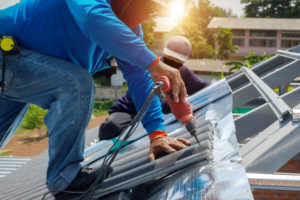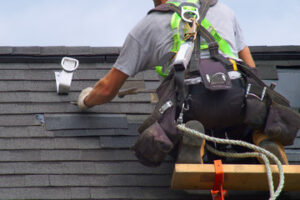Many things can damage your roof. Some, like whirlwinds (or, on land, a tornado), are beyond your control, but others, such as leaks or mold growth, can be easily addressed.
The first step in repairing a roof is inspecting it for damage. This should be done from the inside out, starting at the attic and working your way down through the living spaces. Contact Roof Repair Columbus GA now!

Shingles are a popular choice for roofing material, offering homeowners an affordable and durable option. They are designed to withstand harsh weather conditions and last for decades when well maintained. They also provide sound insulation, keeping indoor temperatures comfortable and reducing utility costs. However, like any roof component, they can damage or deteriorate over time. There are many signs that indicate the need for shingle repair or replacement, including missing or cracked shingles, moss and algae growth, sagging areas, water damage or interior staining.
When a shingle is damaged, it exposes the underlying layers to the elements, which can lead to further problems such as leaks and moisture damage. If left unaddressed, these issues can escalate into more serious and costly repairs. It’s important to address any shingle issues as soon as you notice them to prevent further damage and minimize the cost of repair.
A damaged or aging shingle roof can also affect your home’s energy efficiency and increase your monthly utilities. Gaps and cracks in the shingle roof allow air to escape, which can cause your HVAC system to work harder and raise your energy bills. Regular maintenance and periodic shingle roof restoration can significantly extend the lifespan of your shingle roof and help you save on energy costs.
In addition to being an attractive exterior feature, a healthy shingle roof can increase your home’s value and appeal. Buyers may be deterred from purchasing your home if they see signs of missing or damaged shingles, and it can be difficult to sell your property if you have an unstable roof.
The most common type of shingle is the asphalt shingle, which is affordable and easily recognizable. It comes in various colors, styles and textures to suit any property’s aesthetics. It’s also easy to replace a single shingle, which makes it a more convenient and budget-friendly alternative to other roofing materials. However, you should always consult a professional to identify any underlying issues that need repair before replacing your shingle roof. They’ll know what to look for and recommend the best solution.
Flashing
Flashing, a small yet crucial element of roofing, prevents water from seeping into a structure through the gaps where roof surfaces join. Usually made of metal, this material is also commonly used to seal penetrations like chimneys and skylights. The precise installation of roof flashing is essential to a watertight home.
Flashing is often interleaved with shingles and is fixed to the roof by using nails or roofing cement. To repair damaged flashing, the first step is to remove the damaged piece and then use the existing flashing as a template. The new piece of flashing is cut and bent to fit the application, with special attention being paid to ensure a tight seal where the flashing meets the roof and walls. Nails are then secured, and the surrounding shingles are nailed back in place. Roofing cement is also a great option for repairing flashing, as it can be brushed on and sanded down to provide an extra layer of protection.
Water stains on ceilings or interior walls are unmistakable indicators of moisture penetration and typically point to compromised or damaged flashing. Whether caused by rust or corrosion, cracks or breakage, or simply ageing, this damage undermines the flashing’s critical function of barring water penetration and extending the life of a roof. By swiftly addressing this warning sign, homeowners can save on costly repairs and maintenance work down the road.
In addition to ensuring proper flashing installation, regular inspections and prompt repairs are key to a long-lasting roof. Inspecting the area around chimneys, dormers, and roof edges for signs of water leaks should be top of mind for every homeowner. A thorough examination should also include a check of gutters and flashing along walls adjoining the roof. Regular cleaning and securing of these areas will help prevent blockages and pooling of water that can wreak havoc on the roof system. For the best results, it is advisable to hire professional roofers for flashing installations and repairs. They can be trusted to provide a high-quality and durable solution to all your roofing needs.
Built-up roofing (BUR)
Built-up roofing (BUR) systems have been in use for more than 150 years because they work well in many different geographic areas and climates. They are a good option for commercial buildings with flat or low-sloped roofs, and they can be used on buildings of any size. BUR systems use multiple layers of asphalt and other material to protect the building from weathering and water intrusion. Because of this redundant construction, they are extremely durable and can often last 30 or more years without needing repairs.
The base sheet is fastened to the roof deck or insulation to prevent vapor movement and blisters (soft bubbles caused by trapped moisture). Hot bitumen is then applied over the base sheet, saturating and forming a waterproofing layer. A layer of reinforcing fabric is then installed over the bitumen, providing strength and stability to the roof. A surfacing layer, such as gravel or mineral granules, provides UV protection and helps manage water runoff. Some surfacing options, like reflective coatings, are also available to enhance energy efficiency and meet specific design requirements.
While the layered construction of BUR systems offers durability and longevity, it can make it more challenging to repair leaks than other roofing materials. Leaks can travel through several layers of the roof, making it difficult for an inexperienced service technician to pinpoint the source and make the necessary repairs. Additionally, the surfacing layer can obscure damage, making it difficult to identify problem areas.
To help keep a BUR system in good condition, routine maintenance is important. It should include cleaning the surface to prevent debris from pooling and inspecting the roof for signs of damage. Prompt repair of minor issues like open joints, blisters, or cracks can extend the roof’s lifespan and avoid costly replacement or repairs down the road.
Insulation
Insulation is one of the most important components of a roof. It provides a barrier to prevent heat from escaping during winter and keeping the indoor air cool during summer, saving energy and making living more comfortable. In addition, insulation protects against moisture infiltration and condensation that can lead to mold and mildew. This is a significant problem because these problems can damage other roofing materials and cause structural damage to the building.
It’s crucial to inspect and maintain your roof to ensure it is well-insulated. Having proper roof insulation will help reduce your heating and cooling costs, improve livability, and extend the life of your roof. Insufficient insulation can result in increased wear and tear on the roof, which leads to expensive repairs. In addition, a poorly insulated roof can affect the interior of your home, leading to high energy bills, discomfort, and health issues.
Regularly inspecting your insulation can help you detect problems and address them promptly. If you notice that your insulation is damaged or has gaps, you can use weatherstripping and caulking to seal these areas. Using insulation with a higher R-value, which is a measurement of thermal resistance, can also boost the energy efficiency of your roof.
The R-value of insulation depends on the climate and the design of your home. In colder climates, you may need to choose a more dense material with a higher R-value, such as fiberglass insulation. In warm climates, a loose-fill or cellulosic insulation with a lower R-value can be used.
If you have noticed that the roof is leaking or you see water stains on the ceiling, it’s time to schedule a repair. Leaking roofs can result in damage to the structure of your building, pest infestations, mold and mildew, higher energy costs, and problems with resale. If you are not sure whether to repair or replace your roof, Roundhay Roofing can offer expert advice and assistance. They can help you identify the source of the leak and provide solutions that will fix it and save you money. Contact them to schedule an appointment today.
